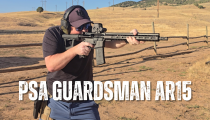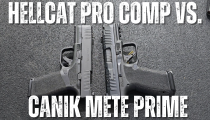Staccato XC Review
Get the Staccato XC here: https://bit.ly/3XOHHAW
The Staccato XC is a premium 9mm pistol built on the 2011 platform, a modern evolution of the classic 1911 design pioneered by John Browning. The 2011 concept emerged in the early 1990s when Sandy Strayer and Virgil Tripp, founders of STI International, reimagined the single-stack 1911 into a double-stack configuration to boost magazine capacity while retaining the 1911’s renowned trigger and ergonomics. STI, based in Georgetown, Texas, originally focused on competition shooting, crafting high-performance pistols that dominated practical shooting circuits like USPSA and IPSC. Over decades, their designs racked up numerous championships, cementing a reputation for precision and reliability.
In 2020, STI rebranded to Staccato, signaling a shift beyond competition guns toward a broader market, including law enforcement and civilian self-defense. The XC, introduced as part of this transition, blends the race-gun heritage of STI with practical features suited for diverse use cases. It’s not a budget option—priced around $4,299 in its base configuration—but reflects a lineage of handcrafted firearms aimed at shooters who prioritize performance over cost. Today, Staccato’s workforce includes over 25% veterans, and the company emphasizes American-made components, a detail that resonates with its patriotic branding.
Specifications
The Staccato XC is a full-sized, single-action, hammer-fired pistol chambered in 9mm Parabellum. Here’s a rundown of its key specs:
-
Barrel Length: 5 inches, featuring an integrated compensator (often called an “island barrel” due to its fixed front sight island).
-
Overall Length: Approximately 8.9 inches.
-
Height: Around 5.5 inches.
-
Width: 1.49 inches at the ambidextrous thumb safeties.
-
Weight: Roughly 34 ounces unloaded (varies slightly with configuration), thanks to its steel frame.
-
Magazine Capacity: Ships with two 17-round magazines, though it’s compatible with higher-capacity options like 20- or 21-round mags.
-
Trigger: A crisp 1911-style single-action trigger, averaging around 2.5 pounds pull weight, though some report it closer to 2.6 pounds with minimal take-up and a fast reset.
-
Sights: Fiber-optic front sight (typically red, interchangeable) paired with an adjustable black rear sight. It’s optics-ready via Staccato’s Tactical Optic system, supporting popular red dots like the Trijicon RMR, Leupold Delta Point Pro, or Holosun 507/508 series.
-
Frame: Billet steel with a polymer grip module, textured for control even in wet or gloved conditions.
-
Finish: Diamond-Like Coating (DLC) on the slide for durability and corrosion resistance.
-
Additional Features: Integrated Picatinny rail, flared magwell for faster reloads, ambidextrous thumb safety, and a grip safety with a subtle speed bump.
The standout feature is the integrated compensator, part of Staccato’s FlaTec technology, which vents gas upward to reduce muzzle flip and felt recoil. This, combined with the steel frame’s heft, makes the XC notably smooth to shoot, especially for rapid follow-ups. The double-stack design delivers higher capacity than a traditional 1911, aligning with the 9mm’s popularity for its balance of recoil, cost, and effectiveness with modern ammo.
Design and Performance Context
The XC’s roots in competition shooting are evident. The 5-inch barrel and compensator keep the muzzle flat, a trait shooters praise for maintaining sight alignment during strings of fire. At the range, it’s described as “soft” and “clean”—recoil pushes straight back into the palm rather than flipping upward, a contrast to uncompensated pistols like the Staccato P or even some tricked-out Glocks. This makes it a favorite among competitive shooters, but its size and weight (over 2 pounds unloaded) mean it’s less ideal for concealed carry compared to compact siblings like the Staccato CS or C2.
Law enforcement has taken notice too. While the Staccato P is the go-to duty model—approved by over 325 agencies, including the Texas Rangers and U.S. Marshals SOG—the XC’s performance has earned it a niche among tactical professionals who value its shootability over portability. Civilians drawn to home defense or range time also appreciate the confidence it inspires, though its price tag often sparks debate about value versus alternatives like a tuned Glock 17 or a Springfield Prodigy.
The 2011 platform itself isn’t unique to Staccato—companies like Wilson Combat and Springfield Armory have their own takes—but Staccato’s execution sets a benchmark. The XC’s trigger, often lauded as one of the best in its class, avoids the mushiness of striker-fired guns, offering a clean break that appeals to 1911 purists. Critics, however, point out quirks like the odd ledge on the compensator or the hump under the thumb safeties, which some feel clash with its premium aesthetic.
Historical Evolution and Relevance
The XC builds on STI’s DVC series, race guns designed for speed and accuracy. Where the DVC-P had a similar island barrel, the XC adds a railed frame and optics compatibility, bridging competition and duty roles. This reflects a broader trend: the 9mm’s dominance over .45 ACP, driven by cheaper ammo, higher capacity, and improved ballistics with hollow-point rounds. Staccato’s move away from .45 entirely underscores this shift, though it’s left some traditionalists grumbling.
The rebrand to Staccato wasn’t just cosmetic. It marked a deliberate pivot to mainstream appeal, backed by real-world testing—over 1,000 rounds through early Staccato models showed consistent accuracy and low recoil, a legacy the XC inherits. Its adoption by elite units and competitive shooters alike suggests it’s more than hype, though its cost keeps it out of reach for casual owners.
Final Thoughts
The Staccato XC is a high-end tool rooted in a rich history of innovation. It’s a 9mm 2011 that excels at delivering flat, fast shooting thanks to its compensated barrel, hefty frame, and refined trigger. Born from STI’s competition pedigree, it’s evolved into a versatile option for those who can justify the investment—whether for sport, duty, or personal defense. It’s not flawless; the price stings, and its bulk isn’t for everyone. But for shooters who prioritize performance and are willing to pay for it, the XC stands as a modern take on a century-old design, blending old-school craftsmanship with contemporary demands.










